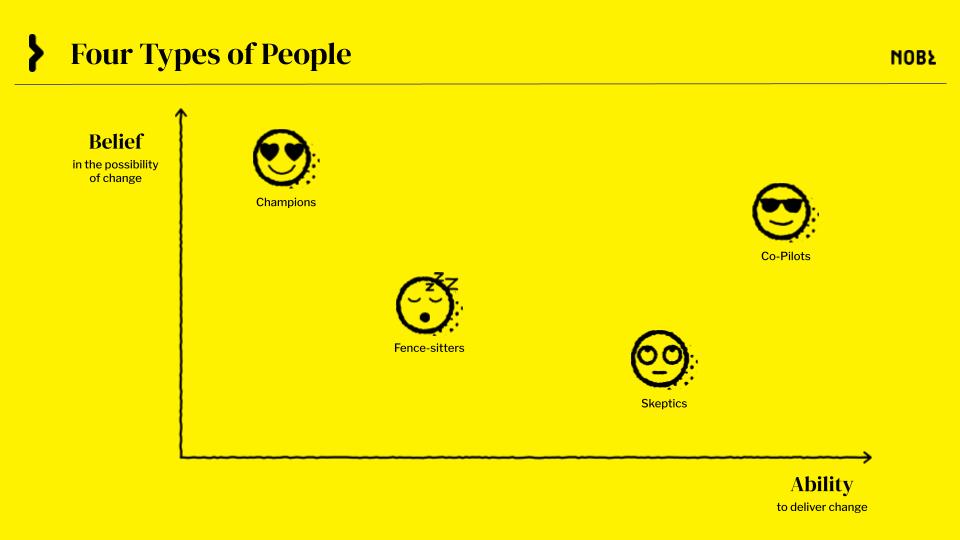We’d all like to think that our attempts to improve the workplace will be enthusiastically welcomed and embraced by our teams. In reality, though, when launching any new change initiative, you’ll encounter four types of people:
- Co-Pilots. These are the folks who will be your very first collaborators and will help you shape your change. Not only that, they have the skills to guide others through the change process.
- Champions. They’re inspired by the possibilities of change. In fact, they may already have tons of ideas on what and how things need to change, even if they don’t necessarily have the skills to deliver it (yet). They’re also crucial sources of influence who help rally the troops.
- Fence-sitters. They aren’t sure the organization will change—but they aren’t sure it won’t, either. Therefore, they’ll “sit it out” and wait for a sign of which way the wind is blowing before they lift a finger to help. This group accounts for about 70% of your organization, therefore for most change initiatives don’t expect to announce a change and be greeted by a vocal response.
- Skeptics. They actively oppose change, and believe the organization or its leaders can’t change. While it’s true that the occasional Skeptic—the cynic—may want you to outright fail, for the most part they’re skeptical because they’ve been hurt before—someone promised to change the organization and failed, or the change stopped short of what was needed, making everything worse.

Once you’ve identified who falls into which camps, you should adopt a different approach to win each over to your cause:
- Shower Co-pilots with resources and attention. Get them involved early and often: organizational change can feel like a slog, but having “wing people” you can trust and confide in will go a long way to making your programs a success.
- Get Champions involved. Delegate projects and decision-making to them for areas they care about, and empower them to assemble others to help. Support their ideas—and if you can’t support all of their ideas, at least be careful not to rain on their parade. Instead, show appreciation for their enthusiasm, and be explicit about the reasoning for why that particular change won’t work. In addition, provide training to any champions who need and want it so they can become full co-pilots.
- Leave the Fence-sitters to others. Get some small wins on the board, and then let the champions and converted skeptics take care of the fence-sitters. Once people see that things are moving forward and that others are on board, they will hop on the bandwagon too.
- Listen to Skeptics at first, but don’t waste time trying to persuade them until you have concrete proof of change. Skeptics’ negativity can be annoying, and it’s tempting to spend a lot of time and energy trying to persuade them to get with the program. Don’t. Your argument isn’t going to beat their evidence. Skeptics usually have some good intel on why change failed in the past, so listen to them and incorporate those past failures into your plans where possible. But then move on and minimize the impact of Skeptics until you have actual proof of change that can challenge their bleak outlook. You usually shouldn’t fully write Skeptics off, because they actually tend to be highly connected and influential members of teams (with long tenures and usually deep skills). So, when you do have early wins, bring those to Skeptics and see if you can flip them into becoming Champions or Co-pilots.
- If you’re dealing with a true Cynic, don’t worry—we have some recommendations to overcome this particular barrier to change.
As tempting as it may be to write off the Skeptics or the Fence-sitters, remember that every type is likely to believe that their way of dealing with change is the only smart, tactical way. And in fact, most are responding sensibly to some aspect of the organizational environment in the messy process of change. Instead of trying to show them why they are wrong, focus on making changes visible. If circumstances change, minds will change, too.













